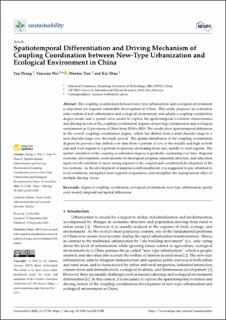| dc.contributor.author | Zhang, Yao | |
| dc.contributor.author | Wei, Taoyuan | |
| dc.contributor.author | Tian, Wentao | |
| dc.contributor.author | Zhao, Kai | |
| dc.date.accessioned | 2024-02-19T13:21:49Z | |
| dc.date.available | 2024-02-19T13:21:49Z | |
| dc.date.created | 2022-10-24T09:06:30Z | |
| dc.date.issued | 2022 | |
| dc.identifier.citation | Sustainability. 2022, 14 (18), . | en_US |
| dc.identifier.issn | 2071-1050 | |
| dc.identifier.uri | https://hdl.handle.net/11250/3118476 | |
| dc.description.abstract | The coupling coordination between new-type urbanization and ecological environment is important for regional sustainable development in China. This study proposes an evaluation index system of new urbanization and ecological environment, and adopts a coupling coordination degree model and a spatial error model to explore the spatiotemporal evolution characteristics and driving factors of the coupling coordination degrees of new-type urbanization and ecological environment in 31 provinces of China from 2010 to 2019. The results show spatiotemporal differences in the overall coupling coordination degree, which has shifted from a mild disorder stage to a near disorder stage over the study period. The spatial distribution of the coupling coordination degrees by province has shifted over time from a pattern of low in the middle and high in both east and west regions to a pattern of stepwise decreasing from east, middle to west regions. The spatial correlation of the coupling coordination degrees is gradually weakening over time. Regional economic development, social security, technological progress, industrial structure, and education input can all contribute to inject strong impetus to the coupled and coordinated development of the two systems. As the development of impetus is still insufficient, it is suggested to pay attention to local conditions, strengthen inter-regional cooperation, and strengthen the superposition effect of multiple driving forces. | en_US |
| dc.language.iso | eng | en_US |
| dc.publisher | MDPI | en_US |
| dc.rights | Navngivelse 4.0 Internasjonal | * |
| dc.rights.uri | http://creativecommons.org/licenses/by/4.0/deed.no | * |
| dc.subject | degree of coupling coordination | en_US |
| dc.subject | ecological environment | en_US |
| dc.subject | new-type urbanization | en_US |
| dc.subject | spatial error model | en_US |
| dc.subject | temporal and spatial differences | en_US |
| dc.title | Spatiotemporal Differentiation and Driving Mechanism of Coupling Coordination between New-Type Urbanization and Ecological Environment in China | en_US |
| dc.title.alternative | Spatiotemporal Differentiation and Driving Mechanism of Coupling Coordination between New-Type Urbanization and Ecological Environment in China | en_US |
| dc.type | Peer reviewed | en_US |
| dc.type | Journal article | en_US |
| dc.description.version | publishedVersion | en_US |
| dc.source.pagenumber | 0 | en_US |
| dc.source.volume | 14 | en_US |
| dc.source.journal | Sustainability | en_US |
| dc.source.issue | 18 | en_US |
| dc.identifier.doi | 10.3390/su141811780 | |
| dc.identifier.cristin | 2064136 | |
| cristin.ispublished | true | |
| cristin.fulltext | original | |
| cristin.qualitycode | 1 | |

